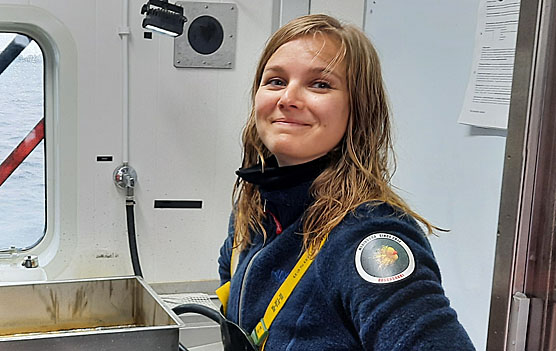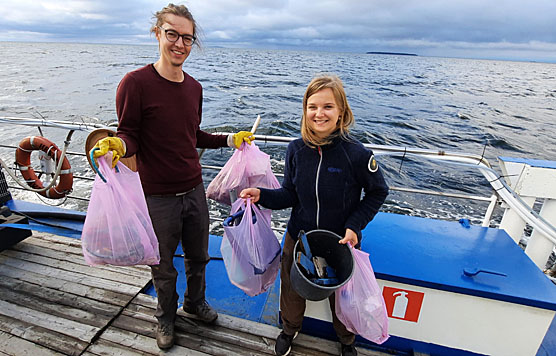Press release 2021-09-07 at 8:27

© Photo: Seppo Knuuttila.
In her doctoral dissertation, Pinja Näkki, a researcher at the Finnish Environment Institute, has experimentally studied risks that organisms such as bivalves living on the seafloor face from microplastics. As much as a quarter of the Baltic clam that were studied ingested microplastics when the surface of the sediment had plastic on it. Microplastics ground from car tyres were found to cause stress and organelle damage to the Baltic clams. Pinja Näkki will defend her dissertation at the University of Helsinki on Friday, 10 September.
Litter in the seas, especially microplastics, have raised considerable attention in recent times. A large part of the litter in the sea sinks to the bottom, gradually breaking into smaller pieces and finally into microplastic. Pinja Näkki's dissertation experimentally examines how microplastics, the organisms on the bottom, and hazardous substances interact.
As many as one in four of the Baltic clams ingested microplastics from the surface of the sediment
Microplastics make their way deeper into the sediment when layers of new material form on top of the old. According to the study, bioturbation, or the movement and feeding of animals in sediment on the seafloor, buried microplastics in the deeper layers. However, bioturbation did not bring microplastics back to the surface of the sediment to any significant degree. “The soft seafloors of the northern Baltic Sea would seem to function as a microplastic sink”, says Pinja Näkki.
The study targeted benthic fauna, such as the Baltic clam, that feed on the top layers of the sediment, and are therefore especially exposed to the microplastics on the surface of the sediment. “As much as 25 percent of the Baltic clams ingested plastics from the surface of the sediment. Microplastics embedded deeper in the sediment were found only in one percent of the Baltic clams”, Pinja Näkki says.
Harmful substances in the microplastics can damage organisms
The harmful substances in plastic materials, such as polycyclic aromatic hydrocarbons, or PAH compounds, may be hazardous to organisms on the seafloor. Many PAH compounds are carcinogenic and can cause genetic damage.
In one of the experiments conducted in connection with the dissertation, microplastics were ground from car tyres. The microplastics were found to contain heavy metals and PAH compounds. “When the Baltic clams were exposed to microplastics from car tyre rubber, they showed stress reactions and damage to their cell organelles. However, we cannot yet draw conclusions from this that these harmful effects would be reflected more extensively at the population level, and further at the level of the entire ecosystem”, Pinja Näkki says.
Microplastics do not carry the sediment's own harmful substances into organisms
When plastics sink to the seafloor, they also come into contact with harmful substances stored in the sediment. The study examined if PAH compounds from the sediments attach themselves to the microplastics. Both conventional and biodegradable plastics were examined.
“The concentrations of PAH compounds in the plastics were clearly lower than those in the sediments. Therefore, ingesting microplastics would not appear to increase the exposure of animals to PAH compounds in the environment”, Pinja Näkki says.
Certain types of biodegradable plastics might pose smaller risks for organisms on the seafloor than traditional plastics do, considering the more diverse bacterial community that developed on the surface of biodegradable cellulose acetate than was the case with conventional plastics. The community may have included groups of bacteria capable of plastic degradation.
“The amounts of microplastics in seas are expected to continue to rise, and the seafloors will continue to be hotspots of microplastics. This is why it is crucial to continue to study the effects of microplastics in these environments”, Pinja Näkki says.
Further information
Pinja Näkki, M.Sc., researcher, Finnish Environment Institute, SYKE
tel. +358 295 251906, firstname.lastname@syke.fi
Pinja Näkki will defend her dissertation on Friday, 10.9.2021 at 13:00 at the Faculty of Biological and Environmental Sciences at the University of Helsinki. The event will be in English.
Address: University of Helsinki, Athena Hall (LS 302), Siltavuorenpenger 3 A, Helsinki. Public seating is limited. The event can also be seen on video (Zoom) (University of Helsinki remote events).
Dissertation: Micro- and mesoplastics in the northern Baltic Sea: their fate in the seafloor and effects on benthic fauna
The dissertation work has been supported by the Walter and Andrée de Nottbeck Foundation, the Doctoral School in Environmental, Food and Biological Sciences at the University of Helsinki (YEB), as well as the UBINAM, MIF, and the campaigns.

Pinja Näkki and Jyri Tirroniemi hold the trash that they had collected from the beaches of the island of Rankki in half an hour when the group of researchers stopped at the annual SYKE monitoring cruise to check on the state of southern waters. © Photo: Seppo Knuuttila.